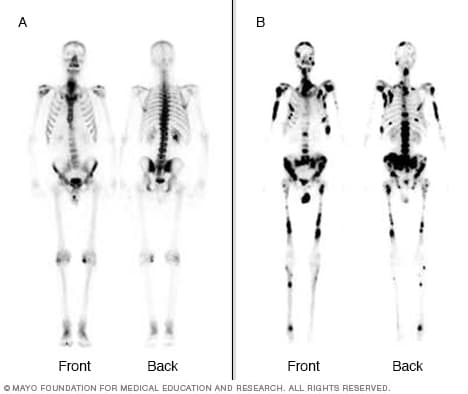Overview
A bone scan is a test that uses nuclear imaging to help diagnose and track several types of bone disease. Nuclear imaging involves using small amounts of radioactive substances, called radioactive tracers, a special camera that can detect the radioactivity and a computer. These tools are used together to see structures such as bones inside the body.
The tracer is absorbed more by cells and tissues that are changing. As a result, a bone scan can be used to find the source of skeletal pain when the cause isn't clear. The source of pain may be a bone infection or a bone injury that doesn't show up on a standard X-ray.
A bone scan also can be an important tool for detecting cancer that has spread to the bone from the tumor's original location, such as the breast or prostate.
Why it's done
Hot spots

Hot spots
Scan A shows hot spots, seen as dark areas, in both knees and the second toe of the right foot. These may be signs of arthritis in the knees and a possible fracture in the toe. Otherwise, the scan shows typical bone metabolism. Scan B shows many bone hot spots, a result of cancer that has spread to multiple locations.
A bone scan might help determine the cause of bone pain that can't be explained. The test is sensitive to differences in bone metabolism, which the radioactive tracer highlights in the body. Scanning the whole skeleton helps in diagnosing a wide range of bone conditions, including:
- Fractures.
- Arthritis.
- Paget's disease of bone.
- Cancer that begins in the bone.
- Cancer that has spread to bone from a different site.
- Infection of the joints, joint replacements or bones.
More Information
Risks
Although the test relies on radioactive tracers to create the images, these tracers produce little radiation exposure — less than a CT scan.
How you prepare
You usually don't need to restrict your diet or restrict activities before a bone scan. Tell your healthcare professional if you've taken a medicine containing bismuth, such as Pepto-Bismol, or if you've had an X-ray test using barium contrast material within the past four days. Barium and bismuth can interfere with bone scan results.
Wear loose clothing and leave jewelry at home. You might be asked to wear a gown for the scan.
Bone scans aren't usually performed on people who are pregnant or nursing because of concerns about radiation exposure to the baby. Tell your healthcare professional if you are pregnant — or think you might be pregnant — or if you're nursing.
What you can expect
A bone scan procedure includes both an injection and the actual scan.
The injection
Tiny amounts of radioactive substances, called radioactive tracers, are injected into a vein in the hand or arm. The amount of time between the injection and scan varies, depending on the reason for the scan.
Some images might be taken immediately after the injection. But the main images are taken 2 to 4 hours later to allow the tracer to circulate and be absorbed by your bones. You might be asked to drink several glasses of water while you wait.
You'll likely be asked to empty your bladder before the scan to remove racer from your body that's not absorbed.
The scan
You'll lie still on a table while an armlike device supporting a tracer-sensitive camera passes back and forth over your body. The scanning procedure can take up to an hour. The procedure is painless.
Your healthcare professional might order a three-phase bone scan, which includes a series of images taken at different times. A number of images are taken as the tracer is injected, then shortly after the injection, and again 3 to 5 hours after the injection.
To better see some bones in your body, your healthcare professional might order extra imaging called single-photon emission computerized tomography (SPECT). This imaging can help with conditions that are especially deep in the bone or in places that are difficult to see. During a SPECT scan, the camera takes images as it rotates around your body.
After the test
A bone scan generally has no side effects, and no follow-up care is needed. You might be asked to drink a lot of water for the next day or two to flush the tracer from your system. The radioactivity from the tracer is usually removed completely two days after the scan.
Results
A specialist in reading images, called a radiologist, looks at the scans for evidence of bone metabolism that's not typical. These areas appear as darker "hot spots" and lighter "cold spots" where the tracers have or haven't collected.
Although a bone scan is sensitive to differences in bone metabolism, it's less helpful in determining the cause of the differences. If you have a bone scan that shows hot spots, you might need more tests to determine the cause.